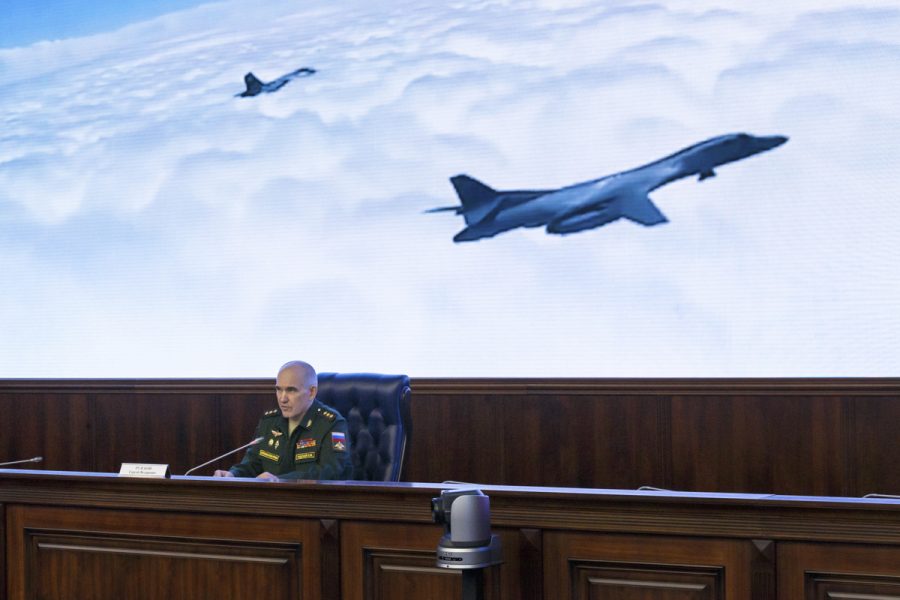Russian President Vladimir Putin’s “new” policy decree authorizing his forces to retaliate against certain kinds of conventional or non-nuclear attacks with nuclear weapons isn’t actually new and doesn’t signal a change in the nuclear posture of either the U.S. or Russia, according to Pentagon and State Department officials.
The announcement came around the same time as a high-level Russian Ministry of Defense press conference detailing a series of grievances about “provocative” U.S. and NATO exercises and flights near Russia.
Officials for both departments, speaking on background, said the statements from Putin align with the view of Russian nuclear posture outlined in the National Defense Strategy and Nuclear Posture Review. Both documents assess that Russia would make up for its inferiority in conventional forces by relying on nuclear weapons in a conflict with the U.S. or NATO. Department experts could not offer official comment until a “certified” translation of the decree is made and analyzed, one said, and that may take some time.
The decree specifically says Russia may respond with nuclear weapons in response to new weapons on the U.S. side—read hypersonic missiles—that could deliver a conventional knockout blow to key elements of the Russian command-and-control structure, albeit without “going” nuclear. The new policy seeks to clarify that any attack on such fundamental elements of state security is worthy of nuclear retaliation, one Defense official said. Such an attack could also be a cyber or electromagnetic pulse attack, or anything else that could cause “failure” of the Russian government’s ability to respond.
The policy also broadens this doctrine to include Russian allies, and suggests that Russia may strike first with nuclear weapons if it has “reliable” information that conventional decapitation weapons are enroute or their launch is planned.
Putin’s policy statement lays out six conditions that will put Russia in fundamental military danger, and thus potentially justify its use of nuclear weapons to “neutralize” them. These include:
- A buildup of hostile forces in the sea or on land adjacent to the Russian federation.
- Deployment by “states that consider the Russian Federation as a potential adversary” of anti-ballistic missile defense systems; short-, and medium-range ballistic missiles; “high-precision non-nuclear and hypersonic” missiles; armed unmanned aerial vehicles, and directed energy weapons.
- Deployment of space-based missile defense and strike systems.
- The deployment of nuclear or other weapons of mass destruction—or their delivery systems—among states such that they “can be used against” Russia.
- “Uncontrolled proliferation” of nuclear weapons and delivery systems, and the technologies used in their manufacture.
- Deployment of nuclear weapons in non-nuclear nations.
The policy follows closely the unraveling of a number of nuclear weapons agreements between the U.S. and Russia.
- In 2019, both sides quit the Intermediate Nuclear Forces treaty, which eliminated theater ground-launched nuclear weapons such as the Air Force Gryphon Ground-Launched Cruise Missile and Army Pershing missile, as well as Russia’s SS-20 and SS-23, among other weapons.
- The U.S. pulled out of the Open Skies treaty last month. It allowed both sides to overfly nuclear facilities as a means of verifying treaty compliance.
- The 2010 New START treaty, governing strategic weapons, expires in eight months, but negotiations on an extension or expansion of that agreement have not yet begun. The Trump Administration has said it would only revisit that agreement if China is brought into it, but China has flatly rejected such a deal, saying its strategic inventory is already much smaller than the U.S. or Russia’s.
During the Russian defense ministry’s June 1 press conference, Colonel-General Serge Rudskoy, chief of the main operational directorate of the general staff, noted recent “provocative” deployments and exercises on the Russian frontier by NATO, with “clearly anti-Russian” intent. The bulk of the press conference discussed the planned Europe Defender 2020 exercise, but those wargames were significantly scaled back due to the COVID-19 pandemic. The Russian defense officials juxtaposed the exercises with recent U.S. withdrawal from the Open Skies treaty and the Intermediate Nuclear Forces Treaty, hinting at dark broader intent.
Rudskoy also noted six flights of B-1B bombers near Russia in 2020, five in May alone, one of which they said came within 10 kilometers of Russian territory. He also complained of reconnaissance flights near Russian territory, including an RQ-4 Global Hawk overflight of Georgia, and increased U.S. military activity in the Arctic.
The Russian armed forces will carefully monitor NATO and American activities “in order to take timely meaures to ensure the security of the Russian federation and prevent incidents,” Rudskoy said, according to state media.
